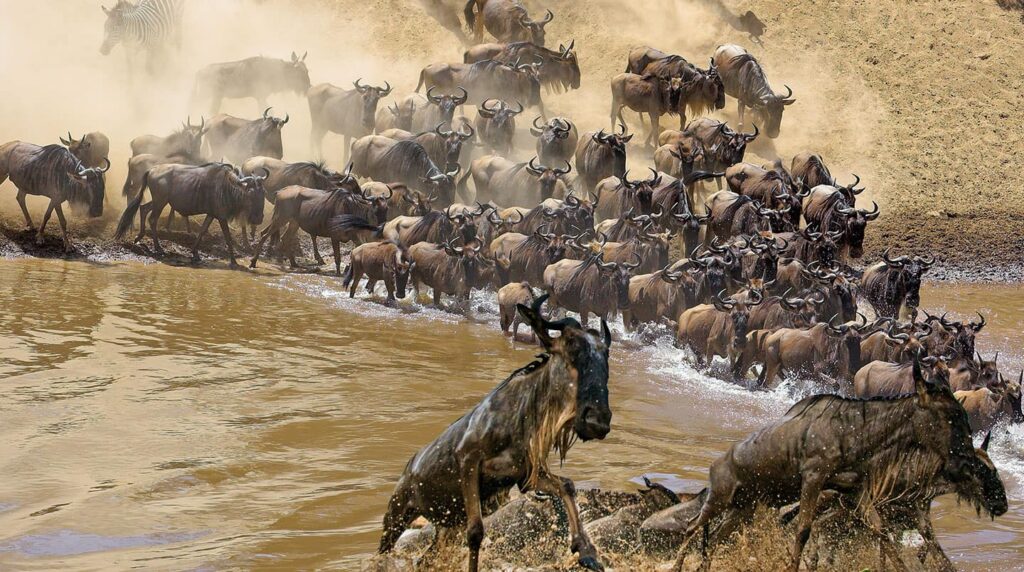Imagine a vast, sun-drenched African landscape, where the horizon stretches endlessly and the air is filled with anticipation. Each year, millions of wildebeests embark on one of nature’s most breathtaking spectacles—the Great Migration. This awe-inspiring journey is not just a test of endurance; it’s a dramatic saga of survival that unfolds across the Serengeti and Maasai Mara ecosystems. In this blog post, we’ll delve into the heart of this extraordinary phenomenon, exploring its intricate rhythms, the challenges faced by these resilient creatures, and the captivating role they play in maintaining ecological balance. Join us as we unveil the mysteries behind nature’s epic march—where every hoofbeat tells a story and every crossing reveals life at its wildest!
Introduction to the Great Wildebeest Migration
The Great Wildebeest Migration is one of nature’s most spectacular events, a breathtaking ballet of life and survival that unfolds across the African savanna. Each year, millions of wildebeests embark on an epic journey in search of greener pastures, facing dangers and challenges along the way. This remarkable migration captures the imagination and draws travelers from around the globe to witness a phenomenon like no other.
Imagine standing on a sun-soaked plain as thousands of these magnificent creatures thunder past you. The sound alone is enough to send shivers down your spine—the earth trembles beneath their hooves while dust clouds swirl in their wake. It’s more than just a sight; it’s an experience that connects you with nature in its rawest form.
Join us as we dive deep into this extraordinary adventure, exploring its history, route, and impact on both wildlife and local communities. Whether you’re planning your first safari or dreaming about it from afar, understanding the wildebeest migration will enhance your appreciation for this awe-inspiring natural wonder.
History and Background of the Migration
The Great Wildebeest Migration has deep historical roots that span thousands of years. This annual journey is not merely a seasonal event; it’s an instinctual pilgrimage driven by the search for greener pastures and water sources.
Wildebeests, also known as gnus, are believed to have evolved in East Africa around 1 million years ago. Their migratory behavior developed as a survival mechanism against harsh climatic conditions.
The migration showcases nature’s resilience and adaptability. It reflects age-old patterns forged by countless generations. Over time, these herds learned to navigate vast landscapes while evading predators lurking along their route.
Cultural significance surrounds this phenomenon too. Local tribes often share stories about the migration, passing down traditions tied to its rhythms and timing. The wildebeest’s epic journey continues to resonate deeply with both people and wildlife alike.
Route and Timing of the Migration
The wildebeest migration is a thrilling spectacle that follows a well-defined route across East Africa. Each year, these remarkable animals embark on their journey through the Serengeti in Tanzania to the Maasai Mara in Kenya.
Typically starting around late April or early May, they begin to move towards greener pastures as the rainy season unfolds. Millions of wildebeests traverse this path, instinctively seeking fresh grazing grounds and vital water sources.
As July approaches, they reach the iconic Mara River. Here, dramatic river crossings take place amidst fierce crocodiles lurking below. The timing is crucial as predators await their opportunity during these perilous moments.
By October, most have migrated back southward toward Tanzania’s Serengeti Plains. This cyclical rhythm is not just about survival; it’s an incredible display of nature’s artistry and resilience against obstacles along their way.
Spectacular Sightings during the Migration
As the wildebeest migration unfolds, nature dazzles with unforgettable scenes. Herds stretch as far as the eye can see, creating waves of movement across the plains.
Predators lie in wait, adding a thrilling edge to the spectacle. Lions and crocodiles are just some of those lurking nearby, ever on alert for their next meal.
Birds also join this grand event. The vibrant colors of flamingos often grace temporary lakes formed during the rains. Their presence enhances the beauty surrounding this monumental journey.
Every sunrise paints a new canvas over these vast landscapes filled with life. Observing such harmony between flora and fauna is mesmerizing.
Witnessing wildebeests crossing rivers is particularly breathtaking. The sheer determination they display while navigating treacherous waters leaves spectators in awe of nature’s endurance and instinct.
Challenges and Survival Techniques of the Wildebeests
The wildebeests face numerous challenges during their migration. Predators lurk at every turn, with lions and crocodiles eagerly waiting for the opportunity to strike. The sheer number of wildebeests can be both a blessing and a curse; while safety in numbers offers some protection, it also attracts attention from hungry hunters.
Water scarcity is another formidable hurdle. As they traverse vast plains, finding reliable water sources becomes critical. Wildebeests have evolved strategies to cope with this challenge by instinctively following established paths that lead to vital watering holes.
In harsh conditions, resilience shines through. These animals are known for their endurance, often traveling long distances without rest or food. Their remarkable ability to adapt ensures survival in an ever-changing environment filled with risks at every step of the journey.
Impact on Ecosystem and local communities
The wildebeest migration is more than just a breathtaking spectacle; it plays a crucial role in maintaining the balance of ecosystems. As these animals traverse vast landscapes, they graze on grasses, promoting new growth and preventing overgrowth. This process aids in fostering biodiversity.
Local communities also benefit significantly from this natural event. The influx of tourists eager to witness the migration creates job opportunities and boosts local economies. Guides, hospitality workers, and artisans all thrive when visitors flock to see this unique phenomenon.
Moreover, the presence of migratory herds helps strengthen traditional ties between wildlife conservation and local cultures. Communities often rally together to protect their natural heritage while preserving their way of life.
Through education and awareness programs linked to the wildebeest migration, locals are empowered to become stewards of their environment. This symbiotic relationship enhances both nature’s resilience and community well-being.
How to Experience the Great Wildebeest Migration?
Experiencing the Great Wildebeest Migration is a dream come true for nature lovers. But it requires careful planning to make the most of this breathtaking spectacle.
Start by choosing your destination wisely. The Serengeti in Tanzania and the Maasai Mara in Kenya are prime locations. Each offers unique perspectives on this natural wonder.
Timing is crucial, too. Aim for late June through October when the herds cross rivers and engage with predators. This thrilling moment often makes for jaw-dropping photography opportunities.
Consider guided safaris or hot air balloon rides to elevate your experience. Professionals know where to find action, ensuring you don’t miss any incredible sights.
Don’t forget essential gear! Binoculars, comfortable hiking boots, and plenty of water will enhance your adventure while keeping you safe and hydrated as you explore the vast landscapes filled with wildlife.
Tips for Planning a Trip to Witness the Migration
When planning your trip to witness the wildebeest migration, timing is everything. Research the peak months for viewing, typically between July and October. This can vary slightly depending on weather patterns.
Choose your base wisely. Popular locations like Maasai Mara in Kenya or Serengeti National Park in Tanzania offer prime spots to see the action.
Book accommodations early, especially during peak season. Options range from luxury lodges to budget campsites.
Consider guided tours led by expert wildlife guides who know where to find the herds. They can enrich your experience with insights into animal behavior and ecosystem dynamics.
Pack essentials: binoculars for close-up views, a good camera for capturing memories, and appropriate clothing for varying temperatures.
Lastly, don’t forget travel insurance that covers safari activities; it’s better to be prepared as you embark on this extraordinary adventure!
Conservation Efforts and Future of the Migration
Conservation efforts play a crucial role in safeguarding the wildebeest migration. Organizations and local communities work together to protect migratory routes from encroachment and habitat loss.
Protected areas, such as Serengeti National Park and Maasai Mara, are vital for ensuring safe passage for herds. These reserves not only maintain biodiversity but also support sustainable tourism that benefits both wildlife and local economies.
Community involvement is key to these initiatives. Educating locals about the importance of preserving natural ecosystems encourages stewardship over land.
Technology has also stepped in to aid conservation. Tracking devices help monitor herd movements while informing conservation strategies tailored to their needs.
As climate change poses new challenges, adaptive management will be essential for the future of this remarkable spectacle. The resilience of nature combined with dedicated human effort can ensure that generations will continue to witness this breathtaking migration.
Conclusion: Why You Should Witness this Epic Journey
Witnessing the Great Wildebeest Migration is an unforgettable experience that transcends mere travel. It’s a front-row seat to nature’s theater, where drama unfolds in real-time. The sheer scale of this journey—over a million wildebeests crossing treacherous terrains—is nothing short of breathtaking.
The sights and sounds are mesmerizing. Picture vast herds thundering across the plains, followed by predators lurking in the shadows, all under the expansive African sky. This event isn’t just about animals; it reflects resilience, instinct, and survival.
Participating in this migration offers more than visual splendor; it’s an opportunity to connect with local communities who have lived alongside these majestic creatures for generations. Their stories add depth to your understanding of this natural spectacle.
Every traveler should seek out such experiences that remind us of our place within nature’s cycle. From planning your trip well to respecting conservation efforts, engaging with the wildebeest migration can change perspectives and foster appreciation for wildlife preservation.
Embarking on this adventure will leave you with memories etched into your heart long after you’ve returned home—the kind that inspires future journeys into wild places where life thrives in its most primal form.






